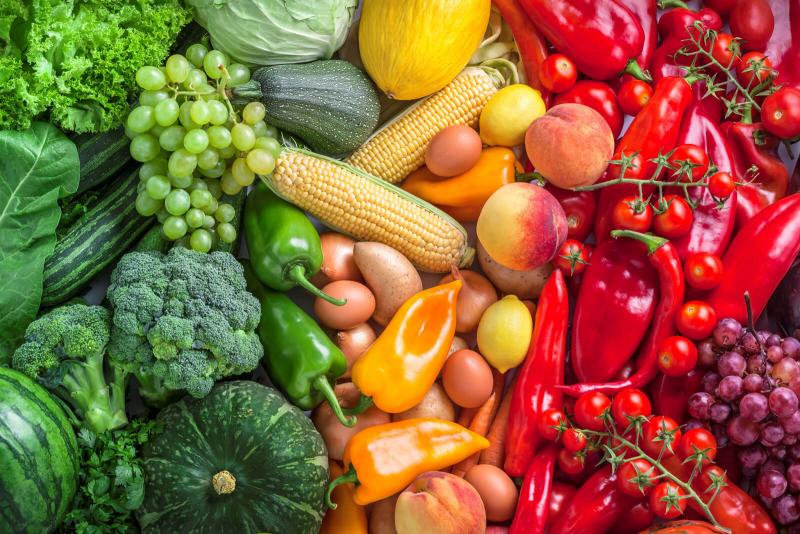
June is National Dairy Month and a great way to start the summer is with nutrient-rich dairy foods. Research has shown that including dairy as part of an overall healthy eating pattern may help reduce risk for high blood pressure, type 2 diabetes, and cardiovascular disease as well as improve bone health. Whether it's protein to help build and repair muscle tissue or vitamin A to help keep skin and eyes healthy, dairy products are naturally packed with nutrients. These are just a few of the reasons to celebrate dairy in June and throughout the year.
Tips for getting daily dairy:
What foods are included? Milk, yogurt, cheese, lactose-free milk and fortified soy milk, and yogurt are included in the Dairy Group. Foods made from milk that have little calcium and a high fat content are not included in the Dairy Group, with examples being cream cheese, sour cream, cream, and butter.
How much is needed? Dairy needs depend on age, sex, height, weight, and level of physical activity. The amount can also depend on whether you are pregnant or breastfeeding. Find the right amount for you by checking out the MyPlate Plan or the following are general recommendations by age:
| Toddlers | 12-23 months | 1⅔ to 2 cups |
|---|---|---|
| Children | 2-3 years old | 2 to 2½ cups |
| 4-8 years old | 2½ cups | |
| Girls & Boys | 9-18 years old | 3 cups |
| Women & Men | 19 years and older | 3 cups |
What counts as a cup? In general, 1 cup of milk, yogurt, or soy milk and 1 ½ ounces of natural cheese count as 1 cup from the Dairy Group. Additional examples that count as 1 cup from the Dairy Group include:
| Milk | 1 cup milk or calcium-fortified soy milk |
|---|---|
| 1 half-pint container milk or calcium-fortified soy milk | |
| ½ cup evaporated milk | |
| Yogurt | 1 cup yogurt (dairy or fortified soy) |
| Cheese | 1 ½ ounces hard cheese (cheddar, mozzarella, Swiss, Parmesan) |
| ⅓ cup shredded cheese | |
| 1 ounce processed cheese (American) | |
| ½ cup ricotta cheese | |
| 2 cups cottage cheese | |
| 2 ounces Queso fresco | |
| 2 slices Queso blanco |
What are the benefits? Consuming foods in this group provide vital nutrients for health and maintenance of your body. Highlights of a few are below:
- Calcium - is used for building bones and teeth and in maintaining bone mass. Dairy products are the primary source of calcium in many American diets. Intake of dairy products is linked to improved bone health and may reduce the risk of osteoporosis.
- Potassium - Eating foods that are a good source of potassium may help maintain a healthy blood pressure. Dairy products, especially yogurt, milk, and fortified soy milk, provide potassium.
- Vitamin D - functions in the body to maintain proper levels of calcium and phosphorous, thereby helping to build and maintain bones. Milk and soy milk fortified with vitamin D are good sources of this nutrient. Other sources include some fish (e.g., salmon) and vitamin D-fortified foods.
For those who choose not to eat or drink dairy products. If you avoid milk because of lactose intolerance, there are still several ways to get calcium in your diet. You can choose alternatives lower in lactose such as cheese or yogurt, consume lactose-free milk, or consume the enzyme lactase before consuming milk products. There are also calcium choices for those who do not eat or drink dairy products, that are not part of the Dairy Group. The amount of calcium your body can absorb from these foods may vary: Calcium fortified juices, Calcium fortified plant-based milk alternatives (e.g., rice or almond milk), tofu made with calcium sulfate, canned fish (such as sardines and salmon with bones), and some leafy greens (e.g., collard and turnip greens, spinach, kale, and bok choy).
Getting more dairy into your diet. Try including fat-free or low-fat milk as a beverage at meals. If you usually drink whole milk, switch gradually to fat-free milk, to lower saturated fat and calories, try reduced-fat (2%), then low-fat (1%), and finally fat-free (skim). Dairy foods also make great snacks, such as eating fat-free or low-fat yogurt by itself using it to make a dip for fruits and vegetables or making fruit-yogurt smoothies in the blender. Another option would be to use shredded low-fat cheese to top casseroles, soups, stews, or vegetables. There are lots of options when it comes to getting your daily dairy.
Sources:
International Dairy Foods Association. (2023). June is National Dairy Month. Accessed at: https://www.idfa.org/june-is-national-dairy-month.
National Dairy Council. (2023). Dairy Nutrition. Accessed at: https://www.usdairy.com/dairy-nutrition.
United States Department of Agriculture. (2023). MyPlate. Dairy Group. Accessed at: https://www.myplate.gov/eat-healthy/dairy.
Tags:
Feedback Form
Feedback Form
If you do not see the article, please scroll up the page.








